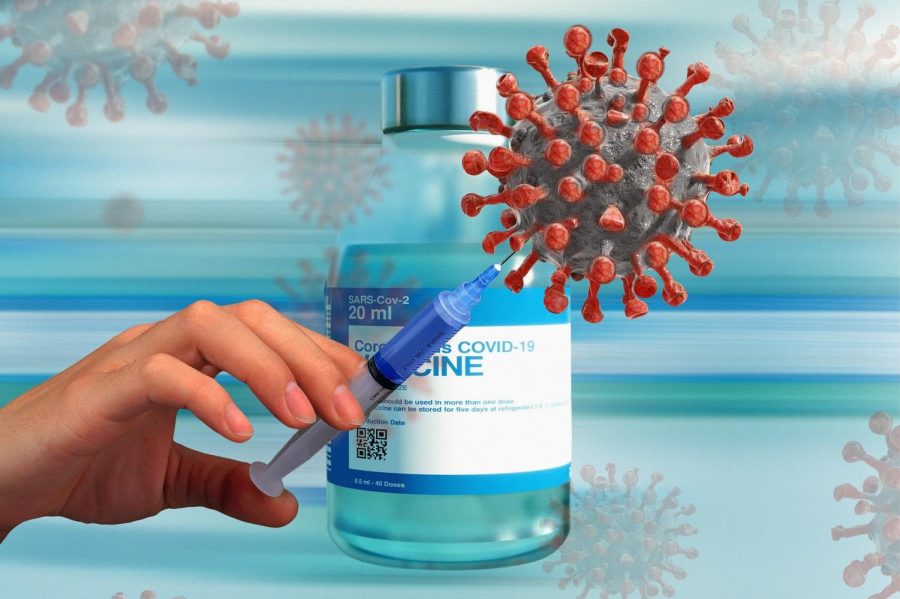Development, Distribution, and Difficulties of the COVID-19 Vaccine
March 1, 2021
“Not your average pocket protector scientist.”
These words were used to describe Dr. Kizzmekia Corbett, one of the head scientists working quickly to develop the coronavirus vaccine. 12 years ago, Corbett was conducting summer work as an undergraduate at the National Institutes of Health, or NIH. However, she had her career goal set: to work in vaccine development. And sure enough, by March of 2020, Corbett would become one of the leaders of the vaccine effort, working at NIH in collaboration with Moderna. Known for her bold personality and unrelenting motivation, Corbett would work long hours each day at the lab to develop the vaccine, knowing how it important it would be to finish it quickly: “A lot of people are banking on us or feel that we have a product that could, at least, be part of the answer this world needs.”
Besides Corbett, other scientists have also been working on the vaccine. Pfizer and Moderna have been the front runners of the vaccine effort, which started as early as January of 2020. As opposed to conventional vaccines, which use a weakened form of the virus, these vaccines make use of mRNA. The mRNA tells our cells to produce spike proteins, which causes an immune response and results in the production of antibodies. These antibodies will then help protect the body from the real virus.
Manufacturing a vaccine is no easy task: the development of a conventional vaccine can take up to 10-15 years. However, significant progress has been made on the COVID-19 vaccine in just a year. By March, Moderna started using the vaccine in human trials, and by July, phase 3 clinical trials began. The milestone achievement of the vaccine effort was in November, where Moderna reported that the vaccine had an effective rate of 94.1%. Pfizer had similar success, with an efficacy rate of 95.0%. Both companies had accomplished a feat that normally takes several years in just a couple of months. “We understood the spike protein of a coronavirus in so much intricate detail, and we had such a good understanding of how to deliver that spike protein via mRNA,” explains Dr. Corbett, who commented on how they were able to develop the vaccine in such a short time. “We were fairly confident that we would be able to work together to fuel this vaccine development trajectory – really, out of necessity, and also science.” With these very promising results, it seemed as if the vaccine could be distributed soon.
However, there are a plethora of logistical challenges that must be addressed before widespread distribution can occur. First, the mRNA vaccine must be kept at very cold temperatures (the Pfizer vaccine must be stored at temperatures of -94° F). Large amounts of staff are also required, with jobs including coordinators who schedule the appointments and the people who administer the shot. There also definitely won’t be enough vaccines for everyone, and with the first vaccines going to healthcare employees, first responders, and other essential workers, it will be a while before high schoolers can expect to be vaccinated themselves. In fact, the New York Times predicts that a high schooler is behind 186 million people in the line to be vaccinated in the US. In other words, students shouldn’t expect to be vaccinated at least for another couple of months.
Technical problems aside, there has also been resistance to the vaccine. Protests and movements against the vaccine have been increasing in number, with many claiming that the mask mandates and vaccine violate their rights. Even healthcare workers are worried about the vaccine. According to Politico, National Nurses United (a nursing union) “is fighting against any vaccination mandates until detailed data from the Moderna and Pfizer trials is publicly available.” These nurses, who weren’t skeptical of vaccines in the past, have concerns about the new COVID-19 vaccines. Fears about the mRNA vaccine interfering with the genetic material have been slowly growing as well. However, Dr. Corbett assures that there is no need to be afraid of the vaccine: “The [mRNA] message does not get integrated into your human DNA. The initial effects of what’s being expressed by this mRNA in your body is very short-lived. So we’re not, you know, making you into a superhuman machine or anything like that.” Corbett believes that although people have a right to be distrustful, she hopes that she can earn that trust back “brick by brick.”
Overall, great advances have been made in the vaccine effort. Despite the numerous obstacles, many dedicated and motivated scientists, like Corbett herself, worked around the clock to finish the vaccine by this year. Vaccinations have already begun, and many are working tirelessly to overcome the technical challenges of vaccine distribution. If things go well, Corbett and her fellow scientists plan “to have people vaccinated all over the world by [this] spring.” By then, we will hopefully be able to leave our houses, remove the masks, and overcome this pandemic together.







